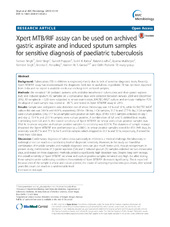Xpert MTB/RIF assay can be used on archived gastric aspirate and induced sputum samples for sensitive diagnosis of paediatric tuberculosis
Singh, Sarman; Singh, Amit; Prajapati, Suneel; Kabra, Sushil K.; Lodha, Rakesh; Mukherjee, Aparna; Singh, Varinder; Hesseling, Anneke C.; Grewal, Harleen
Peer reviewed, Journal article
Published version

Åpne
Permanent lenke
https://hdl.handle.net/1956/11743Utgivelsesdato
2015-09-29Metadata
Vis full innførselSamlinger
Originalversjon
https://doi.org/10.1186/s12866-015-0528-zSammendrag
Background: Tuberculosis (TB) in children is neglected, mainly due to lack of sensitive diagnostic tools. Recently Xpert MTB/RIF assay has revolutionized the diagnostic field, but its usefulness in pediatric TB has not been reported from India and no report is available on its use on long term archived samples. Methods: We recruited 130 pediatric patients with probable intrathoracic tuberculosis and their gastric aspirate (GA) and induced sputum (IS) samples on 2 consecutive days were collected between January 2009 and December 2012. All samples (n = 520) were subjected to smear examination, BACTEC-MGIT culture and in-house multiplex PCR. An aliquot of each sample was stored at −80 °C and tested in Xpert MTB/RIF assay in 2013. Results: Sample wise and patient wise detection rate of smear microscopy was 4.4 % and 10 %, while for BACTEC-MGIT culture this rate was 24.4 % and 46.9 %, respectively. Of the 130 day 1 GA samples, 31.5 % and 27.7 % day 2 GA samples were culture positive. Only 17.7 % GA samples were positive on both days. Of the 130 IS samples collected on day 1 and day 2, 15.4 % and 23.1 % samples were culture positive. A combination of GA and IS yielded best results. Combining both GA and IS, the overall sensitivity of Xpert MTB/RIF on smear and culture positive samples was 95.6 %. In smear negative and culture positive samples its sensitivity was 62.5 %. The duration of sample storage impacted the Xpert MTB/RIF test performance (p = 0.0001). In smear positive samples stored for 650–849 days, its sensitivity was 85.7 % and 77.1 % for IS and GA samples which dropped to 33.3 % and 50 %, respectively, if stored for more than 1050 days. Discussion: Confirmatory diagnosis of tuberculosis particularly in children is a medical challenge. No laboratory or radiological test can reach to a satisfactory level of diagnostic sensitivity. However, in this study we foundthat combination of multiple samples and multiple diagnostic tests can give much better yield, though notoptimum. In present study, combination of 2 gastric aspirates (GA) and 2 induced sputum (IS) samples collected on two consecutive days, and tested on three diagnostic methods yielded a significantly high detection rate. Despite long term storage, the overall sensitivity of Xpert MTB/RIF on smear and -culture positive samples remained very high. But after storing these samples under subfreezing conditions thesensitivity of Xpert MTB/RIF decreased significantly. This is expected because even if the sample is smear and culture positive, the count of surviving mycobacteria goes down, after several years this count can reach to a undetectable level. Conclusion: This report shows that smear and culture positive samples stored at subfreezing conditions for several years can be used in the Xpert MTB/RIF assay, while maintaining appreciable diagnostic test sensitivity and specificity.
